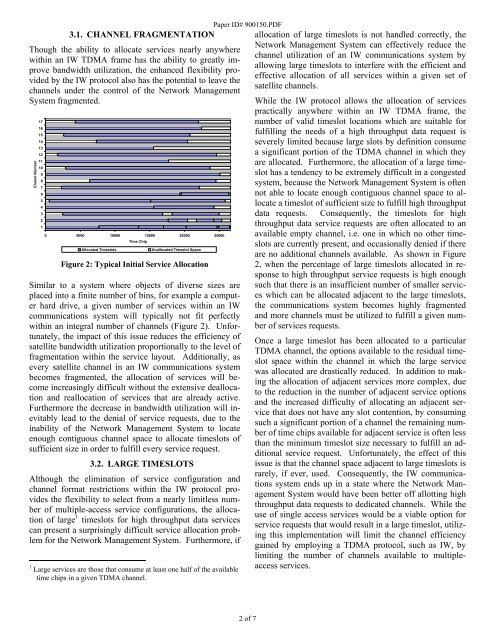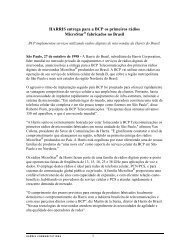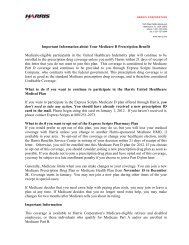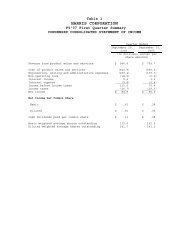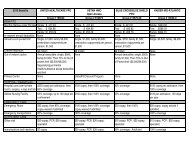METHOD OF ALLOCATING MULTIPLE ASYNCHRONOUS DATA ...
METHOD OF ALLOCATING MULTIPLE ASYNCHRONOUS DATA ...
METHOD OF ALLOCATING MULTIPLE ASYNCHRONOUS DATA ...
You also want an ePaper? Increase the reach of your titles
YUMPU automatically turns print PDFs into web optimized ePapers that Google loves.
Paper ID# 900150.PDF<br />
3.1. CHANNEL FRAGMENTATION allocation of large timeslots is not handled correctly, the<br />
Though the ability to allocate services nearly anywhere<br />
within an IW TDMA frame has the ability to greatly improve<br />
bandwidth utilization, the enhanced flexibility provided<br />
by the IW protocol also has the potential to leave the<br />
channels under the control of the Network Management<br />
Network Management System can effectively reduce the<br />
channel utilization of an IW communications system by<br />
allowing large timeslots to interfere with the efficient and<br />
effective allocation of all services within a given set of<br />
satellite channels.<br />
System fragmented.<br />
While the IW protocol allows the allocation of services<br />
practically anywhere within an IW TDMA frame, the<br />
17<br />
number of valid timeslot locations which are suitable for<br />
16<br />
15<br />
14<br />
fulfilling the needs of a high throughput data request is<br />
severely limited because large slots by definition consume<br />
13<br />
12<br />
11<br />
a significant portion of the TDMA channel in which they<br />
are allocated. Furthermore, the allocation of a large time-<br />
10<br />
9<br />
slot has a tendency to be extremely difficult in a congested<br />
8<br />
system, because the Network Management System is often<br />
7<br />
6<br />
not able to locate enough contiguous channel space to al-<br />
5<br />
4<br />
3<br />
locate a timeslot of sufficient size to fulfill high throughput<br />
data requests. Consequently, the timeslots for high<br />
2<br />
1<br />
0 5000 10000 15000 20000 25000<br />
throughput data service requests are often allocated to an<br />
available empty channel, i.e. one in which no other time-<br />
Time Chip<br />
slots are currently present, and occasionally denied if there<br />
Allocated Timeslots Unallocated Timeslot Space<br />
are no additional channels available. As shown in Figure<br />
Figure 2: Typical Initial Service Allocation<br />
2, when the percentage of large timeslots allocated in response<br />
to high throughput service requests is high enough<br />
such that there is an insufficient number of smaller services<br />
which can be allocated adjacent to the large timeslots,<br />
the communications system becomes highly fragmented<br />
and more channels must be utilized to fulfill a given number<br />
of services requests.<br />
Chanel Number<br />
Similar to a system where objects of diverse sizes are<br />
placed into a finite number of bins, for example a computer<br />
hard drive, a given number of services within an IW<br />
communications system will typically not fit perfectly<br />
within an integral number of channels (Figure 2). Unfortunately,<br />
the impact of this issue reduces the efficiency of<br />
satellite bandwidth utilization proportionally to the level of<br />
fragmentation within the service layout. Additionally, as<br />
every satellite channel in an IW communications system<br />
becomes fragmented, the allocation of services will become<br />
increasingly difficult without the extensive deallocation<br />
and reallocation of services that are already active.<br />
Furthermore the decrease in bandwidth utilization will inevitably<br />
lead to the denial of service requests, due to the<br />
inability of the Network Management System to locate<br />
enough contiguous channel space to allocate timeslots of<br />
sufficient size in order to fulfill every service request.<br />
3.2. LARGE TIMESLOTS<br />
Although the elimination of service configuration and<br />
channel format restrictions within the IW protocol provides<br />
the flexibility to select from a nearly limitless number<br />
of multiple-access service configurations, the allocation<br />
of large 1 timeslots for high throughput data services<br />
can present a surprisingly difficult service allocation problem<br />
for the Network Management System. Furthermore, if<br />
1 Large services are those that consume at least one half of the available<br />
time chips in a given TDMA channel.<br />
2 of 7<br />
Once a large timeslot has been allocated to a particular<br />
TDMA channel, the options available to the residual timeslot<br />
space within the channel in which the large service<br />
was allocated are drastically reduced. In addition to making<br />
the allocation of adjacent services more complex, due<br />
to the reduction in the number of adjacent service options<br />
and the increased difficulty of allocating an adjacent service<br />
that does not have any slot contention, by consuming<br />
such a significant portion of a channel the remaining number<br />
of time chips available for adjacent service is often less<br />
than the minimum timeslot size necessary to fulfill an additional<br />
service request. Unfortunately, the effect of this<br />
issue is that the channel space adjacent to large timeslots is<br />
rarely, if ever, used. Consequently, the IW communications<br />
system ends up in a state where the Network Management<br />
System would have been better off allotting high<br />
throughput data requests to dedicated channels. While the<br />
use of single access services would be a viable option for<br />
service requests that would result in a large timeslot, utilizing<br />
this implementation will limit the channel efficiency<br />
gained by employing a TDMA protocol, such as IW, by<br />
limiting the number of channels available to multipleaccess<br />
services.


